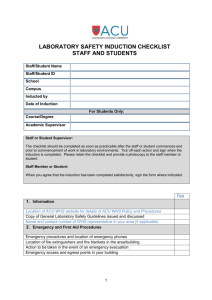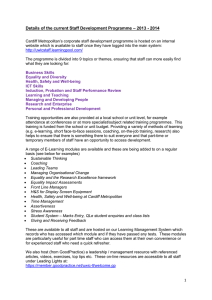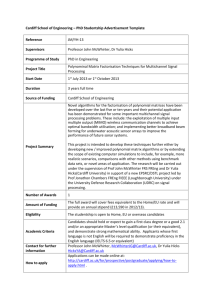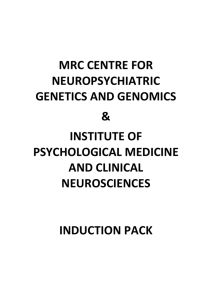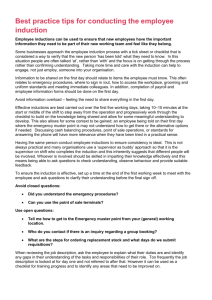safety, health and environmental information
advertisement
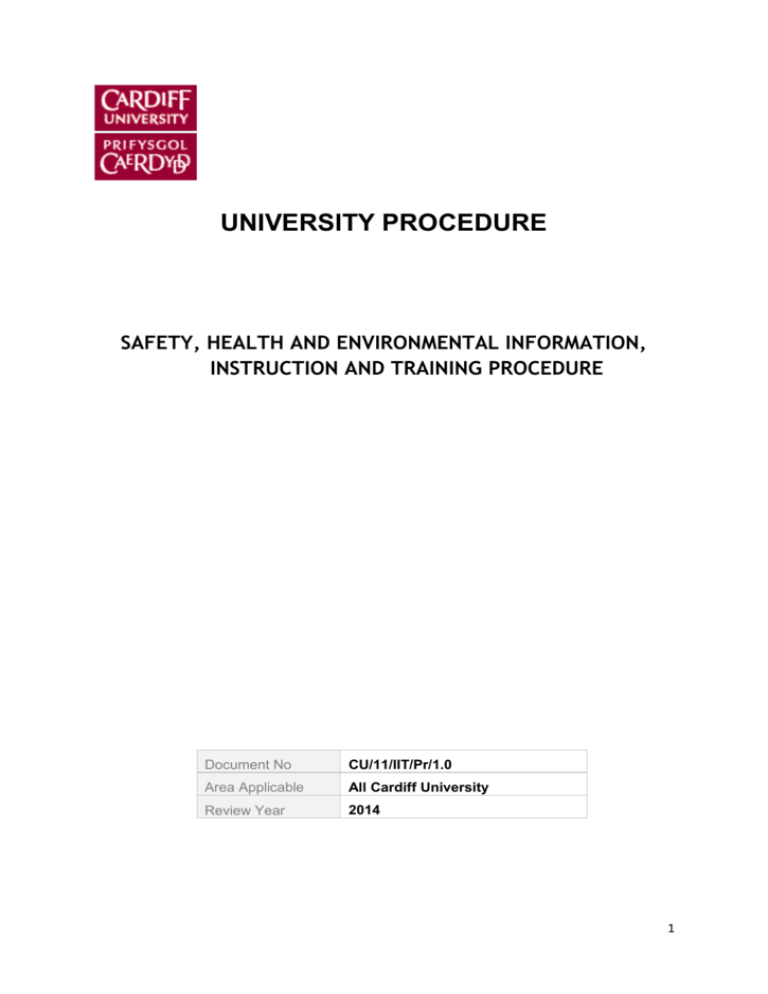
UNIVERSITY PROCEDURE SAFETY, HEALTH AND ENVIRONMENTAL INFORMATION, INSTRUCTION AND TRAINING PROCEDURE Document No CU/11/IIT/Pr/1.0 Area Applicable All Cardiff University Review Year 2014 1 Document History Author(s) Revision Number Date Mike Turner Date Amendment Name October 2011 Approved by .01 2 SAFETY, HEALTH AND ENVIRONMENTAL INFORMATION, INSTRUCTION AND TRAINING PROCEDURE I. PURPOSE: To ensure that the University has a methodology for ensuring that an appropriate level of training, instruction and awareness is given to all staff, students and visitors in order that they can operate in a safe and environmentally sensitive way. Furthermore, the Health and Safety at Work etc Act 1974 requires the University to provide whatever information, instruction, training and supervision is necessary to ensure, so far as is reasonably practicable, the health and safety at work of staff, students and visitors. II. SCOPE: This procedure applies throughout the University and the same standards should be communicated to external companies hosting Cardiff University staff and students by members of staff responsible for managing these arrangements. III. DEFINITIONS: Training: activity aimed at imparting information and / or instruction to improve a person’s performance or to reach a required level of skill or knowledge. Training required by law: mandatory level of training in a process as defined by law e.g. first aid. Training required by the University: obligatory training required by the University in line with the University Training Policy (see: http://www.cardiff.ac.uk/osheu/safety/generalsafety/index.html). Competency: combination of knowledge, skills and behavior which allow a person to undertake a task properly and in a safe, healthy and environmentally conscious way. Corporate Induction: mandatory general induction given when joining the University or when changing divisions in the University Local Induction: area specific structured orientation briefing (see: http://www.cardiff.ac.uk/humrs/newstaff/uniinduction/schoolinduction/in dex.html for University check list). Specialist training: designed to ensure staff and students dealing with specific or extraordinary hazards are competent to do so e.g. radiation work; manual handling; workshop machinery etc. 3 IV. RESPONSIBILITY: Director of OSHEU: is responsible for ensuring that competent advice is available regarding training and for ensuring resources are available for delivery or facilitating delivery of certain safety, health and environmental programmes. Head of School / Directorate: is responsible for ensuring that there staff, students and visitors have received appropriate information, instruction and training and that there are robust systems and resources in-place to identify and deliver the appropriate level of training for staff, students and visitors under their control. Managers / Supervisors: It is the responsibility of the manager / supervisor of the task to ensure that the person(s) undertaking the operation have sufficient knowledge to minimise the health, safety and environmental risk associated with the task. They must ensure that persons under their control: Understand the risks and controls identified through risk assessments Understand associated safe work procedures Have completed any specific training needs that have been identified for the task before it is carried out. A record of the training must be kept. NB. This includes contractors who may require information and instruction to work safely in a particular area. (also see Section B for considerations for training staff and students) Staff, Students and visitors: are responsible for completing training that has been identified and organized as required to competently carry out their task. 4 Section A: Broad outline of training in the University STAFF New staff attend the university corporate induction. On arrival at the School / Directorate staff and students recieve local induction. Training needs are assessed and training given at the appropriate level in order to carry out the role competently. Factors affecting this will be roles and responsibility, tasks the individual will be required to perform, see Section B [this may involve specialist training]. The university has established a safety, health and environmental Training Policy which can be accessed at: http://www.cardiff.ac.uk/osheu/safety/generalsafety/in dex.html Advice from OSHEU regarding health, safety and environment training / awareness Review of training needs is carried out annually through formal staff appraisal (see procedure: http://www.cardiff.ac.uk/humrs/training/perfreview/app raisal/index.html), systems for monitoring performance and through the Risk Management Procedure. Also risk assessment reviews and results of accident investigations 5 STUDENTS Undergraduate Post graduate Local general induction given on arrival in the School. Local general induction given on arrival in the School Teaching Practical Classes Research Group Supervisor of the practical gives specific safety, health and environmental briefing based on the risk assessment ensuring that the relevant level of instruction, information and training required to carry out the practical competently is met. Supervisor of the postgraduate will give specific safety, health and environmental briefing based on the risk assessments in place and will ensure that any training requirements are addressed prior to starting the work. Research Groups / Placements Supervisor of the research group ensures that that the relevant level of instruction, information and training required to carry out the research project competently is met and that there is a clear understanding of the associated risk assessments. In addition the supervisor will highlight all other hazards in the area to which the student has access. Student placement supervisors will ensure that there are mechanisms in place in the chosen placement to ensure that the student has the relevant level of instruction, information and training required to carry out their work competently. 6 Section B: Key considerations for training staff and students STEP 1 Identify what training is required Identify the skills and knowledge needed for staff and students to do their job in a safe, healthy and environmentally conscious way. Compare these against people’s current skills and knowledge and identify the gaps. Review your experience of injuries, near misses or cases of ill health. Look at your risk assessments to see where information and/or training have been identified as factors in controlling risks. Consult workers for their views. STEP 2 Decide the training priorities Does the law require specific training to be undertaken? Top priorities would include those where lack of information and/or training might result in serious harm, and those which benefit the largest numbers of staff. Training for new recruits and for people changing jobs or taking on new responsibilities should always be a priority. STEP 3 Choose the training method(s) and resources Consider what are appropriate methods, e.g. - giving information or instruction; - coaching or on-the-job training; - training in the ‘classroom’; - in groups or individually; and - computer-based or interactive learning. : STEP 4 Deliver the training Decide who will provide training Select competent trainers Ensure the information is easy to understand and try to use a variety of training methods to deliver your message. Ensure there is enough time to prepare for the training. STEP 5 Check that the training has worked Do staff and students understand what you require of them? Do they now have the knowledge and skills needed to work safely and without risk to health? Are they actually working as they have been trained? Has there been any improvement in your group’s health and safety performance? What feedback are you getting from line managers and the people who have been trained? Is further information and/or training needed? Was the most suitable training method used? What improvements can be made? Has there been a change in behaviour and practice? It is important to keep records of training, even in-house training. You should monitor training records so that refresher training can be given when needed. 7

